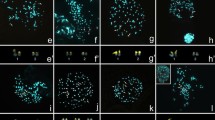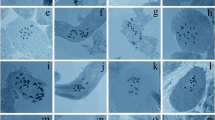Abstract
New or confirmatory chromosome counts for 16 taxa ofHypericum in Britain, one of northwest Africa, and 24 of North and Central America are reported. First records for any member of the genusVisma (n = 10) are also included. The counts are discussed with respect to those previously reported forHypericum and related genera. Some of this chromosomal information is incorporated in a diagram showing suggested evolutionary trends withinHypericum. There appears to be a descending series of basic numbers (x = 12, 10, 9, 8, 7), of which all but the last have been recorded in polyploid, as well as diploid, form. Observations of chromosome morphology suggest thatHypericum is cytologically relatively unspecialized. Studies of chromosome morphology, therefore, are not likely to yield much information about the evolutionary history of the genus. It is suggested that the basic number forAllanblackia andPentadesma is 7 or 14, whereas inCalophyllum andMesua it is probably 8 or 16. Known gametic chromosome numbers inMammea (n = 16, 18) andGarcinia (n = 24, ca. 27, ca. 29, ca. 38, ca. 40, and 48) do not indicate an obvious basic number for these genera, although x = 8, 9, and 16 might be involved. Ring-formation of theOenothera-type, possibly indicative of structural hybridity, is reported for the first time inHypericum mitchellianum Rydb., a close relative ofHypericum punctatum Lam., which was previously shown to possess this anomalous chromo some condition.
Similar content being viewed by others
Literature Cited
Bell, C. R. 1965.In: Documented plant chromosome numbers 65: 3. Sida2: 168–170.
Böcher, T. W. 1940. Studies on the plant-geography of the North-Atlantic Heath-formation. I. The heaths of the Faroes. Kgl. Danske Viden. Selskab. Biol. Meddel.15(3): 1–64. (Hypericum, pp. 30–32).
Borgmann, E. 1964. Anteil der Polyploiden in der Flora des Bismarckgebirges von östneuguinea. Zeit. Bot.52: 118–172.
Bostick, P. E. 1965.In: Documented plant chromosome numbers 65: 2. Sida2: 165–168.
Chattaway, M. M. 1926. Notes on the chromosomes of the genusHypericum, with special reference to chromosome size inH. calycinum. British Jour. Exp. Biol.3: 141–143.
Darlington, C. D. &E. K. Janaki Ammal. 1945. Chromosome Atlas of Cultivated Plants. London: George Allen & Unwin, Ltd. 397 pp.
—. 1947. The Handling of Chromosomes. Ed. 2. London: George Allen & Unwin, Ltd. 180 pp.
—. 1955. Chromosome Atlas of Flowering Plants. Ed. 2. London: George Allen & Unwin, Ltd. xix + 519 pp.
Diers, L. 1961. Der Anteil an Polyploiden in der Vegetationsgürteln der Westkordillere Perus. Zeit. Bot.49: 437–488.
Favarger, C. 1959. Notes de caryologie alpine. III. Bull. Soc. Neuchâtel Sci. Nat.82: 255–285.
Gagnieu, A. &J. P. Wilhelm. 1965. GenreHypericum. In: Gagnieu, A., Les chromosomes dans la cellule, la plante, l’espece. Trav. Biol. Vég. déd. Prof. Plantefol. Paris: Masson. Pp. 472, 473.
Hair, J. B. &E. J. Beuzenberg. 1959. Contributions to a chromosome atlas of the New Zealand flora—2. Miscellaneous families. New Zealand Jour. Sci.2: 148–156.
Hedberg, Inga &Olov [Hedberg] 1964. Documented chromosome numbers of Swedish plants. Svensk. Bot. Tidskr.58: 125–128.
Hoar, C. S. 1931. Meiosis inHypericum punctatum. Bot. Gaz.92: 396–406.
—. 1932. Meiosis in the genusHypericum Bot. Gaz.93: 197–204.
Horn, C. L. 1940. Existence of only one variety of cultivated mangosteen explained by asexually formed “seed.” Science n.s.92: 237–238.
Krishnaswamy, N. &V. S. Raman. 1949. A note on the chromosome numbers of some economic plants of India. Current Sci.18: 376–378.
—. 1954. Chromosome numbers of some Indian economic plants. Current Sci.23: 64–65.
Larsen, K. 1962. Contribution to the cytology of the endemic Canarian element. Bot. Notiser115: 196–202.
Lewis, W. H., H. S. Stripling, &R. G. Ross. 1962. Chromosome numbers of some angio sperms of the southern United States and Mexico. Rhodora64: 147–161.
Mangenot, Simone &G. [Mangenot]. 1957. Nombres chromosomiques nouveaux chez diverses dictoylédones et monocotylédones d’Afrique occidentale. Bull. Jard. Bot. Bruxelles27: 639–654.
—. 1958. Deuxième liste de nombres chromosomiques nouveaux chez diverses dicotylédones et monocotylédones d’Afrique occidentale. Bull. Jard. Bot. Bruxelles28: 315–329.
Matsuura, H. &T. Sûto. 1935. Contributions to the idiogram study in phanerogamous plants. I. Jour. Fac. Sci. Hokkaido Univ. V. Bot.5: 33–75.
Meyer, J. R. 1943. Colchicine-feulgen leaf smears. Stain Tech.18: 53–56.
Mulligan, G. A. 1957. Chromosome numbers of Canadian weeds. I. Canadian Jour. Bot.35: 779–789.
Nielsen, N. 1924. Chromosome numbers in the genusHypericum. (A preliminary note.) Hereditas5: 378–382.
Noack, K. L. 1939. überHypericum Kreuzungen. VI. FortpflanzungsverhÄltnisse und Bastarde vonHypericum perforatum L. Zeitschr. Induk. Abstamm. Vererb.76: 569–601.
Raven, P. H., D. W. Kyhos, &A. J. Hill. 1965. Chromosome numbers of spermatophytes, mostly Californian. Aliso6: 105–113. (Hypericaceae, p. 109.)
Robson, N. K. B. 1956. Studies in the genusHypericum. Unpubl. Ph.D. Thesis. Edinburgh Univ.
— 1957.Hypericum maculatum Crantz. Proc. Bot. Soc. British Isles2: 237, 238.
Rogers, J. L. 1965.In: Documented plant chromosome numbers 65: 1. Sida2: 163–165.
Sharma, J. H. &V. Swamp. 1962. Chromosome numbers of some wild ornamental shrubs of Kulu Valley. Current Sci.31: 26–27.
Sorsa, V. 1962. Chromosomenzahlen Finnischer Kormophyten. I. Ann. Acad. Sci. Fenn. Ser. A. IV. Biol.58: 1–14.
Sugiura, T. 1936. Studies on the chromosome numbers in higher plants, with special reference to cytokinesis. I. Cytologia (Tokyo)7: 544–595.
— 1939. Studies on the chromosome numbers in higher plants. III. Cytologia (Tokyo)10: 205–212.
— 1944. Studies on the chromosome numbers in higher plants. VI. Cytologia (Tokyo)13: 352–359.
Suzuka, O. 1950. Chromosome numbers in pharmaceutical plants, I. Rept. Kihara Inst. Biol. Res.1950(4): 57, 58.
Thombre, M. V. 1964. Studies inGarcinia indica Choisy. Sci. Cult.30: 453–454.
Tixier, P. 1953. Données cytologiques sur quelques Guttiférales du Viet-Nam. Rev. Cytol. et Biol. Vég.14: 1–12.
— 1960. Données cytologiques sur quelques Guttiférales récoltées au Laos. Rev. Cytol. et Biol. Vég.22: 65–70.
Treub, M. 1911. Le sac embryonnaire et l’embryon dan les angiospermes. Nouvelle série de recherches. Ann. Jard. Bot. Buitenzorg24: 1–17.
Winge, O. 1925. Contributions to the knowledge of chromosome numbers in plants. La Cellule35: 305–324. (cf. pp. 312–319.)
Author information
Authors and Affiliations
Rights and permissions
About this article
Cite this article
Robson, N.K.B., Adams, P. Chromosome numbers in Hypericum and related genera. Brittonia 20, 95–106 (1968). https://doi.org/10.2307/2805614
Issue Date:
DOI: https://doi.org/10.2307/2805614




